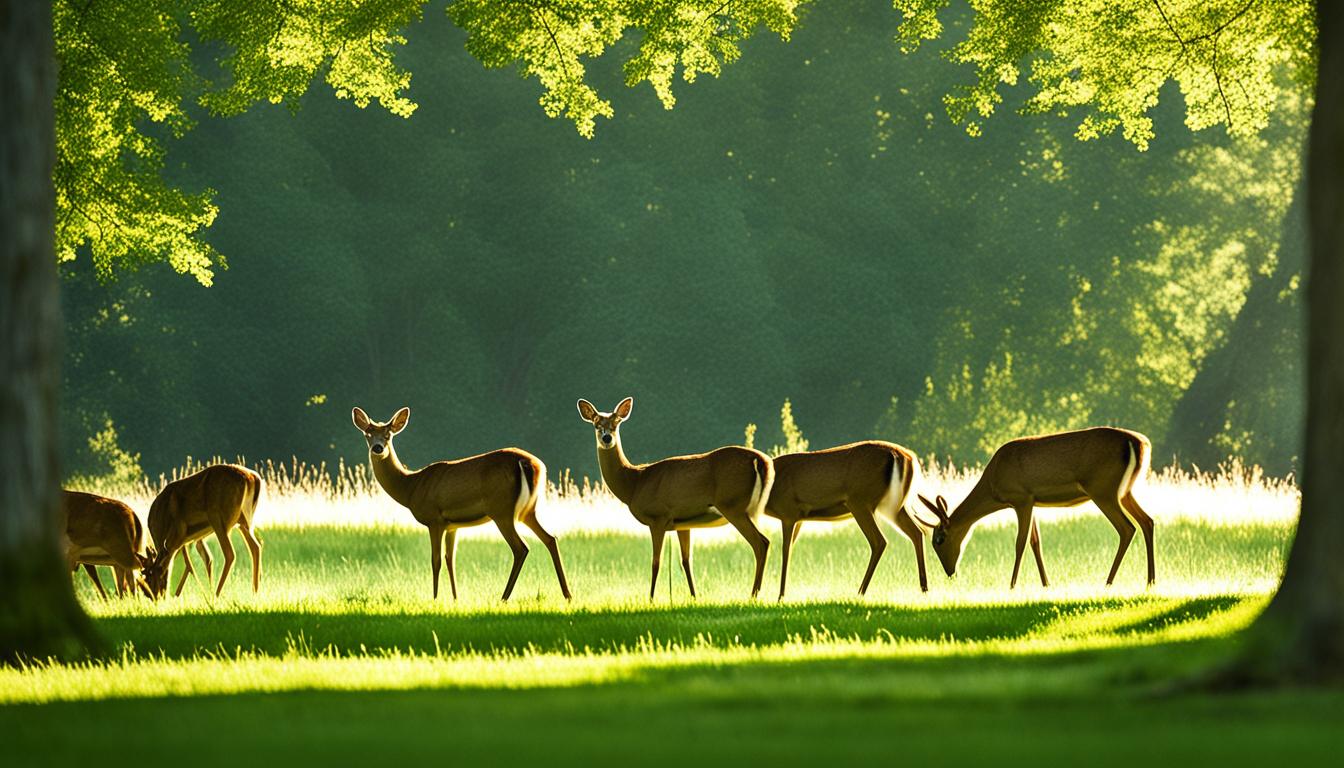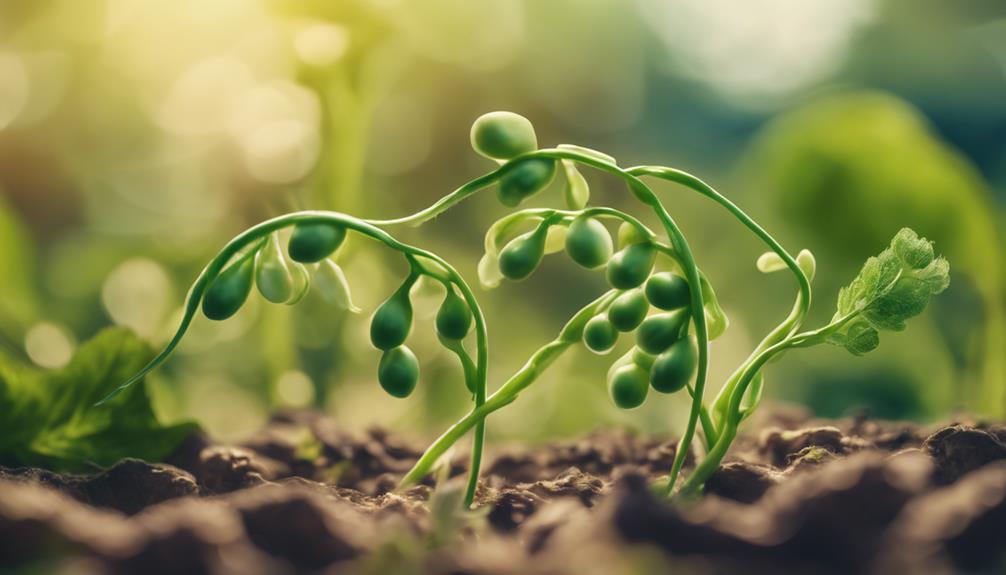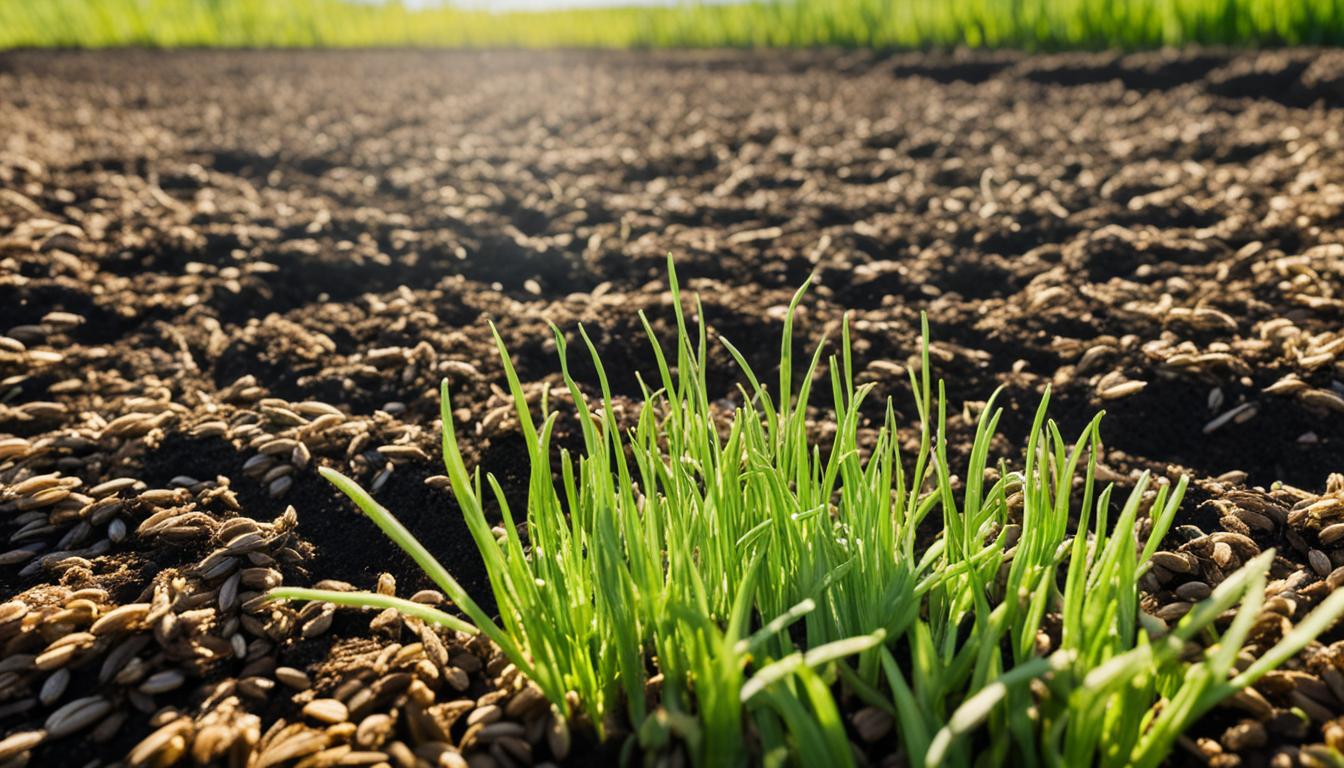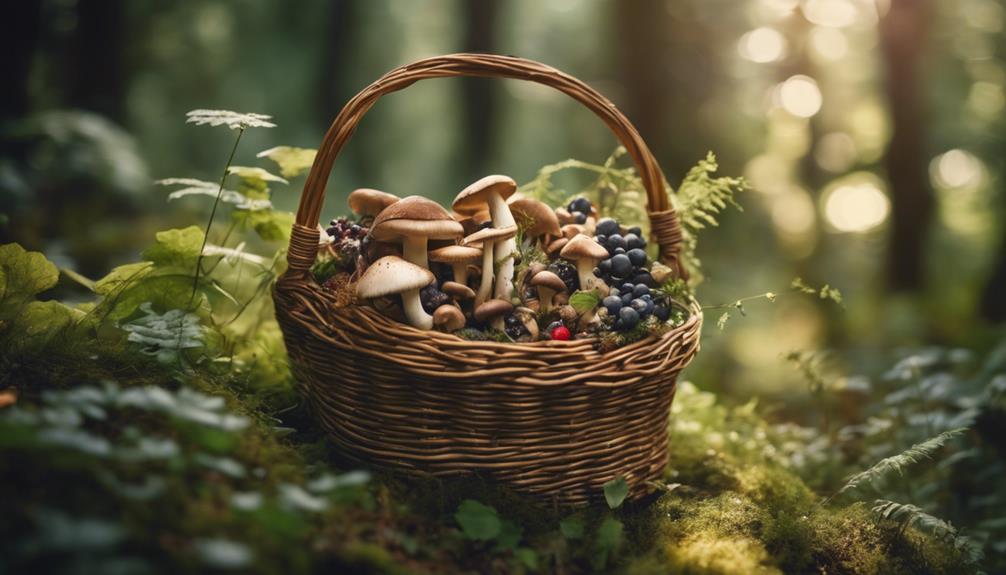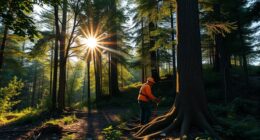Knowing how much food your cows eat every day is very important. It helps keep them healthy and productive. You need to feed them the right amount of forage. This way, they get what they need without you spending too much.
Different things affect how much a cow eats. These include the cow’s weight, the quality of the forage, and whether the cow is producing milk or not. For example, cows that weigh 1,200 pounds and eat average-quality hay will eat about 27 pounds of it every day1. On the other hand, if you feed your cows corn silage, they will eat about 28.5 pounds each day1.
Bigger cows eat more than smaller ones when given the same food1. Cows that are making milk also eat more1. The quality of the food matters too. For instance, cows eating wheat straw with low protein and nutrients will eat less. They typically eat about 1.6% to 1.8% of their body weight each day1.
It’s key to know how much your cows need to eat. This helps you feed them right. You have to think about their weight, the food’s quality, and if they are making milk. This way, your cows get all their nutrients, and you can manage your costs better.
Key Takeaways:
- Cows eat different amounts of food based on their weight, the food’s quality, and their milk production.
- A group of 1,200-pound cows will eat around 27 pounds of average-quality hay daily1.
- The amount of food a cow needs can be between 1.6% and 2.7% of its body weight. This depends on the food and the cow’s needs123.
- Feeding your cows properly without giving them too much expensive food is important for saving money13.
Understanding Dry Matter Intake vs. As-Is Basis
Feeding cows correctly means knowing dry matter intake versus as-fed intake. This involves considering the moisture in forage. Different forages have various moisture amounts, which changes the feed amount cows eat. By using dry matter to as-fed conversions, farmers know exactly how much forage cows eat.
Forage moisture significantly affects cow’s dry matter intake. Take cereal silage, which has 35% dry matter and 65% moisture4. If a cow eats 30 pounds of this silage, it only gets 10.5 pounds of dry matter4. But 30 pounds of hay at 87% dry matter gives 26 pounds of dry matter4.
Nutrients in feed can vary between as-fed or dry matter basis4. For example, silage with 4% crude protein as-fed jumps to 11% on a dry matter basis4. So, calculating dry matter intake is key for proper nutrition.
Grains and hay usually have more dry matter, around 85% to 88%4. Silage is lower, with about 35% dry matter4. Knowing this helps farmers feed their cows better.
A 1,300-pound beef cow eats about 2% of her body weight in dry matter daily4. Poor-quality forage might drop intake to 1.25% to 1.5% of body weight in dry matter4. But high-quality forage can push intake to about 2.5% of body weight in dry matter4.
Feeder calves eat around 2.5% of their body weight in dry matter too4. As they grow, the percentage for dry matter intake may drop. Yet, the total dry matter they consume goes up4. It’s vital to watch their diet as they grow.
Knowing the difference between dry matter intake and as-fed intake is important for proper feed planning. This lets farmers meet their cows’ dietary needs well. It leads to healthier cows and more productive herds.
Factors Influencing Daily Forage Intake
To grasp how much cows eat daily, it’s key to look at a few major factors. These include the cow’s weight, the quality of the forage, and what stage of production the cow is in. Each plays a big role in how much they eat.
The weight of a cow really matters when figuring out how much they will eat. Bigger cows generally eat more than smaller ones. This is especially true for cows that are lactating. They need more nutrients for milk production, increasing their forage intake significantly5.
Next, the quality of the forage affects how much the cows need to eat. High-quality forages, packed with essential nutrients, let cows eat more because they get more of those needed nutrients. On the contrary, low-quality forages result in lower consumption. If the forage has at least 8 percent crude protein, cows might eat about 2 percent of their body weight in it daily. The best forages, like good alfalfa, silages, or fresh pasture, can be eaten at about 2.5 percent of the cow’s body weight in dry matter each day56.
Whether a cow is pregnant or lactating also changes how much they eat. Lactating cows, with their higher nutrition needs, eat more forage. They need it to meet the demands of milk production6.
The age of the forage is another factor to consider. As forage gets older, it becomes less digestible due to chemical changes. These changes lead to more lignin, which cows have a hard time digesting. So, cows eat less of this older, more mature forage compared to younger, more nutritious forage6.
Understanding how cow weight, forage quality, production stage, and forage maturity work together is crucial. It helps in managing how cows eat for optimal nutrition. By considering these factors, farmers can make sure their cows are getting just the right amount of forage they need.
Estimating Forage Intake based on Forage Quality
Knowing how much cows eat is key to good nutrition management. The quality of their feed plays a big role7. Forages of different qualities provide different nutrients, affecting how much cows eat each day. Let’s explore this effect.
Low-quality forages, which have nutrients under 52%, mean dry cows eat about 1.8% of their weight7. Lactating cows eat around 2.0%. If forages are of average quality, with nutrients from 53% to 59%, cows eat more. Dry cows then eat about 2.0%, and lactating cows about 2.3% of their weight7.
But, with high-quality forages, like those over 59% nutrients, green pasture, and silage, cows eat even more7. Dry and lactating cows can eat about 2.5% to 2.7% of their weight. This is great for their health.
It’s crucial to estimate forage intake by its quality for top-notch nutrition management. By knowing how different forages affect eating, farmers can plan meals better. This ensures cows get the nutrients they need. Additionally, understanding the relationship between forage quality and intake helps farmers optimize feeding strategies. By selecting the right forage for food, they can ensure that each cow’s nutritional requirements are met efficiently. This not only supports healthier livestock but also improves overall farm productivity and sustainability. Moreover, implementing knowledge of **how to forage for food** can give farmers a deeper understanding of sourcing high-quality plants that align with their livestock’s dietary needs. By combining sustainable foraging practices with strategic nutritional planning, farmers can reduce costs and reliance on commercial feeds. This balance promotes both environmental stewardship and the long-term health of their herds.
Impact of Forage Quality on Daily Intake
Forage quality is very important for how much cows eat every day. If the forage has lots of leaves and is easy to digest, cows eat more of it8. They like high-quality forages with many leaves and that are easy to digest. But, low-quality forages like wheat straw are not as tasty or easy to digest because they have less protein and energy8. These low-quality forages move slowly through a cow’s stomach. They also have a lot of lignin, which makes them even harder to digest8.
Good forage gives cows more nutrients. This helps them eat more and meet their needs. But, if the forage is of low quality, cows eat less. This can lead to them not getting enough nutrients8.
Forage quality also impacts how much milk cows produce and how much money farmers make. When cows eat better forage, they produce more milk8. Better forage quality can bring in more money for farmers. In particular, making the forage have less fiber can increase a cow’s income by over $2 a day. This means the milk made from one ton of forage can be worth between $115 to over $300, depending on the quality and the diet of the cow8.
The profit from cows greatly depends on forage quality. If cows only gain 1 lb/day, a farmer might lose $100 per cow. But, if they gain 2.75 lb/day, a farmer could earn $140 per cow. This shows how important good forage is for making money8.
Farmers know that high-quality forage is worth more. They often pay extra for it at hay auctions in Wisconsin. The extra money paid for high-quality hay ranges from $0.83 to $0.91 for every point of Relative Feed Value (RFV) per ton8. The premium for quality has stayed the same over time, from $45 per ton for lower to higher RFV hay, no matter how hay prices change8.
Hay bale size also changes its price. Big round bales cost about $25 less per ton because they’re harder to move8. It’s important to consider this when pricing hay based on its quality.
During times when there’s a lot of hay, the best quality hay sells fast. It’s more profitable for farmers to sell high-quality hay first. This way, they make the most money from the demand for good forage8.
| Comparison of Forage Quality Levels | |
|---|---|
| Quality Level | Average Price Paid ($/ton) |
| Supreme ( | $60 |
| Premium (27-30% ADF) | $50 |
| Good (30-32% ADF) | $40 |
| Fair (32-35% ADF) | $30 |
The chart shows prices paid for different forage qualities in California from 1996 to 20009. It clearly shows that better forage gets higher prices. This encourages producers to improve forage quality89.
Factors Affecting Forage Intake of Cattle
Several factors influence how much cattle eat. These include the cow’s body condition, weather challenges, and management decisions. Fat cows often eat less than leaner ones, affecting total consumption. Cold weather makes cattle eat more, while hot weather does the opposite10. Farmers need to think about these things to meet their cattle’s feed needs.
Other key factors include the type and quality of supplements and how much grass is available. How often cattle graze also matters10. It’s vital for those raising cattle to manage these areas well. This ensures cows get enough to eat and stay healthy.
The quality of the grass also plays a big role. There’s a way to measure grass quality, looking at how much cows will eat and how well they digest it10. The state of the cow’s stomach and the content inside also limit how much they want to eat10. Moisture in the grass affects how picky cows are with what they eat, especially with silage10.
The physical form of forage matters too. Cows prefer softer, easier-to-digest food over tough, coarse grass10. How full the cow’s rumen is and how long the food stays there can hint at how much cows will eat10. The digestion of organic matter and its time in the rumen are closely linked10.
Knowing these intake factors is key for effective cattle feeding and care. Taking care of the cows’ condition, managing weather impacts, and handling feed wisely helps farmers. This ensures cattle get a proper diet for their health and productivity.
Identifying Supplemental Needs for Forage
When feeding cattle with forage-based diets, figuring out what extra nutrients they need is key. This depends on what nutrients the cows require at different times and what the forage offers. By checking the nutrient content, you can find if something’s lacking or if there’s too much of it.
Cows that are about to give birth need 9–11 lb of digestible nutrients daily11. They also need 2 lb of protein each day11. A cow producing milk needs more food, about 15–16 lb of nutrients per day after having a baby11. First-time moms eat 17 percent less food just before they have their calf11. After giving birth, their diet should have at least 62 percent nutrients and 10–11 percent protein11.
The quality of the forage is very important. If the forage has less than 7 percent protein, it’s considered low quality12. High-quality forage has more than 12 percent protein and doesn’t need extra supplements, except for some special cases12. Forage that’s in the middle quality-wise can sometimes make supplements unnecessary12.
When looking at supplements, consider what they’re made of, how much they cost, and how they’ll affect the cows. Dry distillers grains are great for cows making milk11. Giving them 5 lbs a day covers their energy needs11. Young cows getting 1.5–2 lbs of these grains may have better chances of getting pregnant again11. Urea-based products can be used for grown cows in later pregnancy stages11.
Other options for supplements include meals from different seeds, by-products like wheat mids, and different grains12. High-protein cubes are good for cows not producing milk and are fed in small amounts12.
Choosing the right supplement involves looking at the costs per pound of protein or energy. This helps cattle owners make budget-friendly choices11.
Supplementing Low-quality Forage
When cattle producers face low-quality forage, they must explore options to meet their livestock’s needs.
Considering the type of feed is crucial when supplementing low-quality forage. Choices like concentrate feeds or harvested forages can replace pasture forage.

Feeding supplements at 0.5% of body weight13 is key to keeping animals healthy. This stops weight loss. It’s vital for cows that are nursing or need more nutrients. Protein supplements come in various forms, like cubes or pellets. They contain over 20% crude protein. They make cattle eat more and digest low-quality forage better. This keeps cattle performing well.13
Choosing the right supplements is essential. It’s important to match them with the cows’ energy needs. Some supplements, like cottonseed meal or alfalfa hay, might not have enough energy13. Others, like those made from corn, might lower how much forage cows eat13.
The cost of protein supplements should also be considered. For example, Soybean Meal at 50% crude protein costs about $0.39 per protein unit.14 Plus, it’s critical to check winter production costs. They are a big part of the expenses in raising beef cattle.15
To pick the best and most affordable source, testing hay and understanding cattle needs is advised.13 The Nebraska Extension offers a “Feed Cost Cow-Q-Lator” spreadsheet. It helps compare feed costs and supplement prices.13
In short, it’s critical to choose the right supplements for the cattle’s needs when dealing with low-quality forage.. This helps keep animals in good shape and perform well.
Conclusion
It’s key to feed your cattle right to make sure they’re healthy and productive. Farmers need to understand how much food cows eat every day. This depends on their weight, the quality of the food, and their stage of life. Studies show16 cows eat about 2-3% of their body weight in food each day. Milk-producing cows eat more, about 3% of their body weight. Younger cows eat about 2.5% to 3%.
Adding supplements to their diet is very important. This is especially true if the regular food isn’t very good. Supplements17 make sure cows get all the nutrients they need. Farmers should think about things like protein content and the right balance of minerals in their feed. Using things like growth boosters and specific feed additives can help cows grow better. This means farmers get more for their money, as noted in17.
Cows also need certain minerals to stay healthy. Research18 says they need at least seventeen different minerals. These include big minerals and smaller ones. The right amount of minerals helps them grow, fight off sickness, and have babies. It’s important not to give them too many minerals. Farmers must find the perfect balance in their feed.
So, good cattle feeding means understanding their needs, finding the right food, adding supplements, and balancing minerals. By doing these things, farmers keep their cows happy and healthy. This helps their farm do well.
FAQ
How much forage does a cow eat daily?
What is the difference between dry matter intake and intake on an as-is basis?
How do factors like cow weight and forage quality affect daily forage intake?
How does forage quality affect the daily feed capacity of cows?
How does forage quality impact the amount of forage a cow can consume daily?
What are some additional factors that can influence the forage intake of cattle?
How can I supplement low-quality forage?
Why is understanding daily forage intake important for feed planning?
Source Links
- https://beef.unl.edu/cattleproduction/forageconsumed-day – Determining How Much Forage a Beef Cow Consumes Each Day
- https://www.thebeefsite.com/articles/3154/how-much-forage-does-a-beef-cow-consume-each-day/ – How Much Forage Does a Beef Cow Consume Each Day?
- https://extension.okstate.edu/fact-sheets/supplementing-beef-cows.html – Supplementing Beef Cows – Oklahoma State University
- https://www.canadiancattlemen.ca/nutrition/understanding-as-fed-or-dry-matter-when-feeding-cattle/ – Understanding ‘as fed’ or ‘dry matter’’ when feeding cattle
- https://news.okstate.edu/articles/agriculture/2018/stotts_selk-cows-consuming-forage.html – Calculation of livestock’s winter feed needs a must for cow-calf producers – Oklahoma State University
- https://sutton.agrilife.org/files/2011/08/understandingforageintakeinrangeanimals.pdf – Understanding Forage intake in Range Animals
- https://extension.umd.edu/resource/estimating-winter-forage-needs-cow-calf-herd – Estimating Winter Forage Needs of the Cow-Calf Herd
- https://fyi.extension.wisc.edu/forage/does-forage-quality-pay/ – Does Forage Quality Pay?
- https://fyi.extension.wisc.edu/forage/files/2017/04/FQ.pdf – PDF
- https://journals.uair.arizona.edu/index.php/jrm/article/download/7864/7476 – PDF
- https://extensionpublications.unl.edu/assets/html/g2268/build/g2268.htm – NebGuide 2268
- https://bexar-tx.tamu.edu/files/2021/02/EL-5354-Factors-and-Feeds-for-Supplementing-Beef-Cows.pdf – Factors and Feeds for Supplementing Beef Cows
- https://beef.unl.edu/beefwatch/tips-improve-cow-performance-while-consuming-low-quality-forages – Tips to Improve Cow Performance While Consuming Low-quality Forages
- https://u.osu.edu/beef/2019/12/04/supplementing-poor-quality-hay/ – Supplementing Poor Quality Hay
- https://s3.wp.wsu.edu/uploads/sites/2676/2022/03/The_realities_of_low_quality_forages_EM053E.pdf – PDF
- https://discover.texasrealfood.com/raising-cattle/how-much-hay-do-cows-eat-a-comprehensive-guide – How Much Hay Do Cows Eat? A Detailed Guide
- https://extension.psu.edu/ration-formulation-for-growing-cattle – Ration Formulation for Growing Cattle
- https://www.beefresearch.ca/topics/nutrition-in-beef-cattle/ – Nutrition in Beef Cattle


